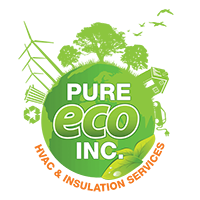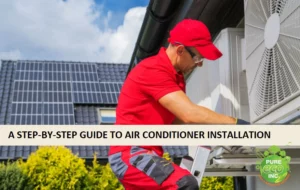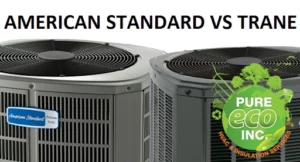What is HVAC?
HVAC (Heating, Ventilation, and Air Conditioning) serves as the backbone of indoor climate control, regulating temperature, humidity, and air quality to create environments tailored to your preferences. It’s what keeps your home warm in the winter and cool in the summer, making sure the air you breathe is just right.
This guide helps you understand your HVAC system better. It will explain all the parts that make it work and how they do their job. If you need more detailed advice about your HVAC system even after going through this information, feel free to get in touch with us for a free consultation – (877) 870-7998
Get Free Estimate!
Request Your Home Comfort Estimate
Key Components of an HVAC System Explained
An HVAC system consists of heating, ventilation, and air conditioning components. Each plays an important role in maintaining indoor comfort and air quality:
- Heating Components
The furnace or water heater serves as the core of your home’s heating system. Furnaces heat air via ductwork and boilers circulate heated water or steam through radiators or radiant floor heating systems.
Heat pumps, on the other hand, offer versatile heating and cooling solutions by transferring heat between indoor and outdoor environments. This provides energy-efficient climate control year-round.
- Ventilation Components
Ductwork distributes heated or cooled air throughout your home. This ensures consistent airflow and temperature regulation for enhanced comfort and energy efficiency. Meanwhile, air filters improve indoor air quality by trapping airborne particles like dust and pollen, which safeguardes against respiratory issues and allergies.
- Air Conditioning Components
The air condenser and evaporator lie at the core of the cooling process. The condenser unit, which is located outdoors, dissipates heat from indoor air. Meanwhile, the evaporator coil inside absorbs heat and cools the air. At the same time, a refrigerant facilitates heat exchange in the air conditioning system by circulating between indoor and outdoor units. This ensures optimal cooling performance and energy efficiency while minimizing environmental impact through proper maintenance and monitoring.
How Does an HVAC System Work?
HVAC systems ensure comfort and air quality at home by continuously adjusting the temperature regardless of outdoor conditions. The heating process begins when the thermostat activates either the furnace or water heater. Furnaces produce heat by igniting fuel and distributing it through ducts, while boilers circulate warm water or steam through radiators or radiant floors. In summer, the air conditioner compresses a refrigerant to cool the indoor air. Ventilation is also important, as it ensures fresh air circulation and removes indoor pollutants for healthier living conditions.
When you grasp the basics of HVAC operation, you can manage your system more effectively and improve its energy efficiency. Also, by understanding how heating, cooling, and ventilation work together, you can optimize performance and ensure comfort year-round.
Get Free Estimate!
Request Your Home Comfort Estimate
Exploring Different Types of HVAC Systems and Their Unique Advantages
Different types of systems cater to different needs and preferences, offering unique benefits and features tailored to specific conditions. Each type of system brings its own set of advantages to the table, ensuring optimal indoor comfort and energy efficiency.
Split systems are commonly seen in homes and businesses alike, dividing into two key parts: an outdoor unit holding the condenser and compressor, and an indoor unit containing the evaporator coil and air handler. The outdoor unit removes heat from inside, while the indoor unit disperses cooled air through ducts. These systems offer versatility, energy efficiency, and personalized control options, making them suitable for various needs.
Packaged HVAC systems present a compact solution by consolidating all components into a single unit, often placed outdoors or on rooftops. They are favored for their space-saving design and straightforward installation, particularly in smaller residences or commercial settings with limited indoor area. Furthermore, packaged systems tend to be more energy-efficient than split systems due to reduced ductwork, minimizing energy loss and enhancing overall system effectiveness.
Ductless mini-split systems emerge as a flexible choice, especially when traditional ductwork installation proves challenging or costly. Comprising an outdoor condenser unit and indoor air-handling units mounted on walls or ceilings, these systems allow for zoning capabilities, enabling independent temperature control for individual rooms or zones. Moreover, by eliminating the need for ductwork, ductless mini-splits enhance indoor air quality and lower energy consumption by preventing air leakage.
Hybrid Heat Pump System combine the efficiency of a heat pump with the reliability of a furnace, offering homeowners versatile heating options to adapt to varying weather conditions. By automatically switching between electric heat pump operation and gas furnace operation based on outdoor temperatures, hybrid systems optimize energy usage and provide consistent comfort throughout the year.
What Does an HVAC System Do?
HVAC systems are essential in regulating indoor environments for comfort and health. During colder months, they provide warmth through heating components like furnaces or heat pumps. In summer, air conditioning units cool indoor environments by removing heat and humidity, offering relief from sweltering temperatures. Furthermore, HVAC systems maintain indoor air quality by continuously circulating and filtering air, and removing pollutants and allergens to promote better respiratory health.
Choose Pure Eco Inc. For All Your HVAC Needs
Have more questions about HVAC and what it stands for? If you’re looking to learn more about HVAC systems and how they can enhance comfort and efficiency in your home or business, feel free to reach out to us at Choose Pure Eco Inc. With over 10 years of experience providing comprehensive HVAC services in California, our team of experts is here to provide answers and assistance tailored to your needs.
Get Free Estimate!
Request Your Home Comfort Estimate
Faq
What Does HVAC Stand For?
HVAC stands for Heating, Ventilation, and Air Conditioning, encompassing systems that regulate indoor temperature, air quality, and humidity. Heating components like furnaces or heater ensure warmth during colder seasons, while ventilation systems remove pollutants and replenish indoor air with fresh outdoor air. Air conditioning units play a crucial role in cooling indoor spaces during hot weather, creating a comfortable environment for occupants.
What is the difference between HVAC and air conditioning system?
While air conditioning specifically focuses on cooling indoor spaces, HVAC (Heating, Ventilation, and Air Conditioning) encompasses a broader range of functions. HVAC systems not only cool indoor spaces but also provide heating during colder months and regulate ventilation to maintain indoor air quality. Essentially, air conditioning is a subset of HVAC
What are the main components of an HVAC system?
The primary components of an HVAC system include heating elements (furnaces, heat pumps), ventilation systems (air ducts, fans), air conditioning units (central AC, split systems), thermostats, and controls.
Why is regular HVAC maintenance important?
Regular maintenance is essential for ensuring HVAC systems’ optimal performance and longevity. By scheduling routine HVAC maintenance checks, homeowners can proactively identify and address potential issues before they escalate, thereby minimizing the risk of costly repairs or premature system failure. Moreover, well-maintained HVAC units operate more efficiently, resulting in lower energy consumption and reduced utility bills. Additionally, proper maintenance helps preserve indoor air quality by ensuring that filters are clean and airflow is unobstructed, creating a healthier living environment. Investing in regular maintenance is a proactive approach to safeguarding the comfort, efficiency, and longevity of HVAC systems.
When should I consider professional HVAC maintenance?
While DIY maintenance is beneficial, hiring professional HVAC technicians for comprehensive maintenance is recommended for addressing complex issues and ensuring long-term system health. Professional maintenance typically includes tasks such as inspecting components, lubricating moving parts, and checking refrigerant levels.
Does Choose Pure Eco Inc. provide HVAC services in California?
Yes, Choose Pure Eco Inc. provides comprehensive HVAC services in California, with over 10 years of experience in the industry. Our team of experts is dedicated to delivering top-notch service and expertise tailored to your specific needs.





